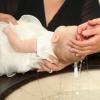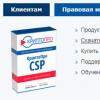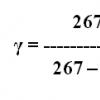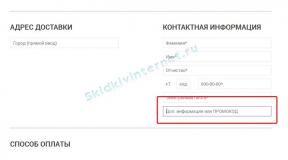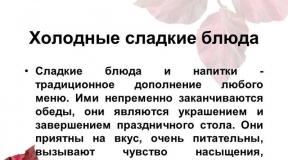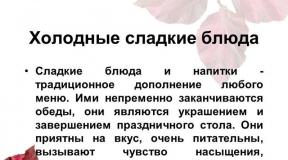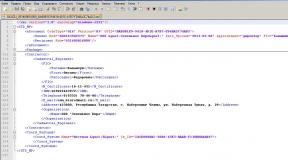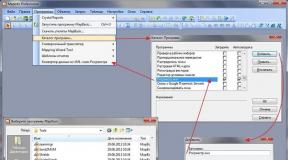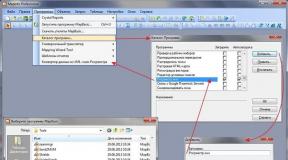What atropine sulfate is used for. Medicinal reference book geotar. Description of the dosage form
1 ml of solution contains 1 mg of atropine sulfate.
Excipients: hydrochloric acid 0.1 M, water for injection.
Description: Transparent colorless liquid. Pharmacotherapeutic group:M-holinoblokator ATX: & nbspA.03.B.A Belladonna alkaloids, tertiary amines
A.03.B.A.01 Atropine
Pharmacodynamics:Atropine (an alkaloid found in plants of the Solanaceae family), a blocker of M-cholinergic receptors, binds equally to the M1, M2 and M3 subtypes of muscarinic receptors. Affects both central and peripheral M-cholinergic receptors. It also acts (although much weaker) on n-cholinergic receptors. Interferes with the stimulating action of acetylcholine; reduces the secretion of salivary, gastric, bronchial, lacrimal, sweat glands, pancreas. Reduces muscle tone of internal organs; causes tachycardia, improves
AV conductivity. Reduces the motility of the gastrointestinal tract, practically does not affect the secretion of bile. Dilates pupils, hinders drainage intraocular fluid, increases intraocular pressure, causes paralysis of accommodation. In moderate therapeutic doses, it has a stimulating effect on the central nervous system and a delayed but long-term sedative effect; stimulates breathing (large doses - respiratory paralysis). Stimulates the cerebral cortex (in high doses), in toxic doses causes excitement, agitation, hallucinations, coma. Reduces tone vagus nerve, which leads to an increase in heart rate (with a slight change in blood pressure) and a slight increase in conductivity in the His bundle. The effect is more pronounced with an initially increased tone of the vagus nerve.After intravenous administration, the maximum effect appears in 2-4 minutes.
Pharmacokinetics:It is widely distributed in the body. It is metabolized in the liver by enzymatic hydrolysis. Communication with plasma proteins - 18%. Penetrates the blood-brain barrier, placenta and breast milk.
In significant concentrations, it is found in the central nervous system after 0.5-1 hours. The half-life is -2 hours. Excretion by the kidneys is 50% unchanged, the rest is in the form of hydrolysis and conjugation products.
Indications:Aggravation peptic ulcer stomach and duodenum; acute pancreatitis; pylorospasm; spasms of the intestines, gallbladder and bile ducts, urinary tract, bronchi; hypersalivation (parkinsonism, poisoning with salts of heavy metals); bradycardia;
AV blockade; poisoning with cholinomimetic and anticholinesterase drugs; premedication before surgery. Contraindications:Hypersensitivity, angle-closure glaucoma (mydriatic effect, leading to an increase in intraocular pressure, can cause an acute attack), tachyarrhythmias, severe congestive heart failure, ischemic disease heart, mitral stenosis, reflux esophagitis, hiatal hernia, pyloric stenosis (possibly decreased motility and tone, leading to obstruction and retention of stomach contents), hepatic and / or renal failure, intestinal atony, obstructive bowel disease, paralytic ileus, toxic megacolon, ulcerative colitis, xerostomia ( long-term use may cause a further decrease in salivation), myasthenia gravis (the condition may worsen due to inhibition of the action of acetylcholine), urinary retention or a predisposition to it, or diseases accompanied by obstruction of the urinary tract (including the cervix Bladder due to hypertrophy prostate), pregnancy toxicosis (possibly increased arterial hypertension), Down's disease, cerebral palsy (the reaction to anticholinergic drugs increases), lactation period.
Carefully:Hyperthermia, open-angle glaucoma, tachycardia, chronic heart failure, arterial hypertension, chronic diseases lungs, acute blood loss, hyperthyroidism, ageover 40 years of age (risk of manifestation of undiagnosed glaucoma), pregnancy. Method of administration and dosage:To relieve acute pain in stomach ulcers and duodenal ulcers and pancreatitis, renal, hepatic colic, etc., the drug is administered subcutaneously or intramuscularly at 0.25-1 mg (0.25-1 ml of solution).
To eliminate bradycardia - intravenously 0.5-1 mg, if necessary, after 5 minutes, the administration can be repeated.
For the purpose of premedication - intramuscularly 0.4-0.6 mg 45-60 minutes before anesthesia.
For children, the drug is administered at a dose of 0.01 mg / kg.
In case of poisoning with m-cholinostimulants and anticholinesterase agents, 1.4 ml of a 0.1% solution is administered intravenously (syringe-tube), preferably in combination with cholinesterase reactivators.
Side effects:Dry mouth, tachycardia, headache, dizziness, intestinal and bladder atony, constipation, difficulty urinating, photophobia, mydriasis, accommodation paralysis, increased intraocular pressure, xerostomia, impaired tactile perception.
Overdose:SymptomsDryness of the mucous membrane of the oral cavity and nasopharynx, impaired swallowing and speech, dry skin, hyperthermia, mydriasis, etc. (see the section "Side effects"); motor and speech excitement, memory impairment, hallucinations, psychosis.
Treatment.Anticholinesterase and sedatives.
Interaction:Weakens the effect of m-cholinomimetics and anticholinesterase agents. or - enhancing the action of atropine.
Nitrates increase the likelihood of increased intraocular pressure. - increased anticholinergic action.
Under the influence of guanethidine, a decrease in the hyposecretory action of atropine is possible.
Special instructions:Atropine should not be abruptly canceled because symptoms similar to withdrawal symptoms may appear.
Influence on the ability to drive vehicles. Wed and fur .:During the period of treatment, it is necessary to refrain from driving and practicing potentially dangerous species activities requiring increased concentration of attention and speed of psychomotor reactions.
Release form / dosage:Solution for injection 1 mg / ml.
Package:In the production of PA LLC "Experimental Plant" GNTSLS ", Ukraine.
1 ml in ampoules.
If there is a fracture ring or a fracture point on the ampoule, the ampoule scarifier or ceramic cutting disc is not inserted into the pack.
During production at LLC Pharmaceutical company"Health", Ukraine.
1 ml in ampoules.
10 ampoules each together with instructions for use and an ampoule scarifier or a ceramic cutting disc in a cardboard box.
5 ampoules in a blister strip made of polyvinyl chloride film or polyvinyl chloride film and aluminum foil, 1 or 2 blister packs each with instructions for use and an ampoule scarifier or ceramic cutting disc in a cardboard box.
Pharmacodynamics.
Atropine sulfate - a blocker of m-cholinergic receptors, binds to the m1 -, m2 - and m3 - subtypes of muscarinic receptors. Affects both central and peripheral m-cholinergic receptors. To a lesser extent, it affects n-cholinergic receptors. Expands the pupil, hinders the outflow of intraocular fluid, increases intraocular pressure, and causes paralysis of accommodation. The atropine dilated pupil does not constrict when instilling cholinomimetic agents. Maximum mydriasis occurs in 30-40 minutes and lasts for 7-10 days.
The systemic effect of atropine is due to blockade of choline receptors and includes inhibition of the secretion of salivary, gastric, bronchial, sweat glands, pancreas, increased heart rate, decreased tone of smooth muscle organs (bronchial tree, organs abdominal cavity and etc.).
Penetrating the blood-brain barrier, atropine affects the central nervous system, in toxic doses causes motor and mental disorders, convulsions, hallucinatory phenomena, respiratory paralysis.
Pharmacokinetics
Atopine sulfate is well absorbed through the conjunctiva, as well as in the gastrointestinal tract when swallowed eye drops that got through the lacrimal canal into the nasopharynx. Atropine has a volume of distribution of 1-6 l / kg, 50% binds to blood plasma proteins. Plasma clearance is 8 ml / min / kg. Atropine crosses the blood-brain barrier and the placenta, and traces of atropine are detected in breast milk. It is metabolized in the liver, excreted by the kidneys unchanged (30-50%) and in the form of metabolites.
Indications for use
Locally in ophthalmology: used as a mydriatic and cycloplegic agent for diagnostic or therapeutic purposes, for cycloplegia and mydriasis in the composition complex therapy inflammatory diseases of the iris and uveal tract.
Method of administration and dosage
Assign 1 drop to the conjunctival sac, pupil dilation develops after 40 minutes. If necessary, it is possible to prescribe 1 drop in the conjunctival sac 2 times a day with an interval between doses of at least 5-6 hours. The dosage regimen and duration of use are determined by the doctor.
Side effect
Local action
: hyperemia of the skin of the eyelids, hyperemia and edema of the conjunctiva, eyelids and eyeball, photophobia, mydriasis, accommodation paralysis, increased intraocular pressure.
Systemic action: dry mouth, tachycardia, nausea, vomiting, intestinal atony, constipation, urinary retention, bladder atony, headache, dizziness, agitation, confusion, hallucinations, ataxia, impaired tactile perception, decreased bronchial secretion.
Development is possible allergic reactions including skin rash, contact dermatitis, anaphylactic shock.
In case of occurrence adverse reactions, including those not specified in the instructions for use, you must stop using the drug and consult a doctor.
Contraindications
Hypersensitivity to atropine sulfate and excipients. Angle-closure glaucoma and patients with risk factors for angle-closure glaucoma. Anterior and posterior synechiae, keratoconus. Childhood up to 7 years.
Carefully
Arrhythmias, chronic heart failure, ischemic heart disease, mitral stenosis, reflux esophagitis, hepatic and / or renal failure, severe urinary retention in prostatic hyperplasia, intestinal atony, obstructive bowel disease, paralytic ileus, toxic megacolon, ulcerative colitis, esophageal hernia apertures of the diaphragm, hyperthermia, arterial hypertension, hyperthyroidism, age over 40 (risk of manifestation of undiagnosed glaucoma), myasthenia gravis.
Overdose
In case of an overdose, the development of systemic anticholinergic effects is possible: cardiovascular disorders, disorders of the central nervous system and other disorders (see section "Side Effects").
Treatment is symptomatic.
Precautionary measures
Hands should be washed before and after the instillation of the drug. Do not touch the eyelids or any other surface with the dropper. Before instilling eye drops, you must tilt your head back, pull the lower eyelid down, look up. After instilling eye drops, it is recommended to close the eye and lightly press with a finger into the area of the projection of the lacrimal sac at inner corner eyes for 1-2 minutes. When the drug is injected into the conjunctival sac in the form of drops, it is necessary to squeeze the portion of the lacrimal passages in order to avoid getting the solution into lacrimal canal and its absorption. IN ophthalmic practice It is advisable to use atropine sulfate primarily with therapeutic purpose, and with a diagnostic one, it is better to use mydriatics of a shorter duration.
The drug is limited to use when elevated temperature body (possibly a decrease in the activity of sweat glands), children with brain damage, children cerebral palsy, patients with Down syndrome (the reaction to m-anticholinergic antagonists increases).
Pupil dilation can provoke an acute attack of glaucoma in patients with risk factors for glaucoma, persons over 60 years of age, patients with hyperopia, who are prone to glaucoma due to the fact that they have a shallow anterior chamber.
Patients should be warned about decreased visual acuity after instillation of eye drops, as well as photophobia and the need to protect the eyes from bright light.
Application data contact lenses during the application of Atropine sulfate are absent.
Pregnancy and lactation
The safety of use during pregnancy and lactation has not been established. Prescribing the drug during pregnancy and lactation is possible only for absolute indications, if the doctor determines that the expected benefit to the mother outweighs the potential risk to the fetus / child.
Pediatrics
Children under 7 years of age are prescribed atropine sulfate in lower concentrations (0.125%, 0.25%, 0.5%).
The ability to influence the reaction rate when driving or operating other mechanisms
During the period of treatment, one should refrain from driving vehicles and engaging in other potentially hazardous activities that require increased concentration of attention, speed of psychomotor reactions and clarity of vision.
A warning
general characteristics:
international and chemical names: atropine; bis (1R, 3r, 5S) 3 - ((RS) - (3-hydroxy-2-phenylpropionyl) oxy) methyl-8-8-azabicyclo (3.2.1) octane sulfate;
Basic physical and chemical properties: clear, colorless liquid;
Compound: 1 ml of solution contains atropine sulfate 1 mg;
excipients: 0.1 M hydrochloric acid, water for injection.
Release form... Injection.
Pharmacotherapeutic group... Anticholinergic medicines.
PBX code A03BA01.
Pharmacological properties.
Pharmacodynamics. The mechanism of action is due to the selective blockade of M-cholinergic receptors by atropine (to a lesser extent affects the H-cholinergic receptors), as a result of which the latter become insensitive to acetylcholine, which is formed in the area of the endings of postganglionic parasympathetic neurons. The ability of atropine to bind to cholinergic receptors is explained by the presence of a fragment in its molecule, which gives it an affinity for the endogenous ligand molecule, acetylcholine. Atropine sulfate reduces the secretion of salivary, bronchial, gastric and sweat glands, increases the viscosity of bronchial secretions, inhibits the activity of cilia of the ciliated epithelium of the bronchi, thereby reducing mucociliary transport, accelerates heart contraction, increases AV conduction, reduces the tone of smooth muscle organs, reduces the number and total acidity gastric juice (especially with the predominance of cholinergic regulation of secretion), reduces the basal and nocturnal secretion of gastric juice, to a lesser extent reduces the stimulated secretion, the pupil is clearly dilated (with a possible increase in intraocular pressure). Penetrating through the blood-brain barrier (BBB), atropine in therapeutic doses stimulates respiration.
Pharmacokinetics. After intravenous administration, the maximum effect appears after 2-4 minutes, after oral administration (in the form of drops) - after 30 minutes. Passes through the BBB. In the blood, atropine binds 50% to proteins, its volume of distribution is approximately 3 l / kg. After intravenous administration, the concentration of atropine in the blood plasma decreases in 2 stages. The first stage - fast - is characterized by a half-life of 2 hours. During this time, approximately 80% of the administered dose of atropine is excreted in the urine. Another part of it is excreted in the urine with a half-life of 13 to 36 hours. Atropine is metabolized in the liver, about 50% of the dose is excreted by the kidneys unchanged.
Indications for use... How symptomatic remedy, with gastric ulcer and 12 duodenal ulcer, pylorospasm, acute pancreatitis, cholelithiasis, cholecystitis, intestinal spasms, urinary tract, bronchial asthma, bradycardia as a result of an increase in the tone of the vagus nerve, to reduce the secretion of salivary, gastric, bronchial, and sometimes sweat glands, to conduct an X-ray examination of the digestive tract (decrease in tone and motor activity of organs).
The drug is also used before anesthesia and surgery and during surgery as a means that prevents broncho - and laryngospasm, reduces the secretion of glands, reflex reactions and side effects caused by excitation of the vagus nerve. In addition, Atropine sulfate is a specific antidote for poisoning with compounds, cholinomimetic and anticholinesterase (including organophosphate) substances.
Method of administration and dosage... Atropine sulfate is administered subcutaneously, intramuscularly, intravenously, and inside. In case of poisoning with cholinomimetics and anticholinesterase substances, a 0.1% solution of Atropine Sulfate is administered intravenously, guided by the antidote therapy regimens for these intoxications, taking into account the use of atropine together with cholinesterase reactivators.
Inside, the drug is prescribed for adults in 4 - 13 drops of a 0.1% solution for taking 1 - 2 times a day before meals or 1 hour after it. Subcutaneously, intramuscularly and intravenously, 0.5-1 ml of a 0.1% solution is injected.
Higher doses for adults inside and subcutaneously: single - 1 mg, daily - 3 mg.
Children of the first 3 months of life are especially sensitive to atropine. Atropine sulfate is prescribed to children parenterally in the following single doses per 1 kg of body weight: newborns and infants - 0.018 mg (0.018 ml of 0.1% solution); from 1 to 5 years - 0.016 mg (0.016 ml of a 0.1% solution); from 6 to 10 years old - 0.014 mg (0.014 ml of a 0.1% solution); from 11 to 14 years old - 0.012 mg (0.012 ml of a 0.1% solution).
Side effect.
Side effect the drug is mainly associated with the m-anticholinergic action of atropine. In large doses, the drug can lead to respiratory paralysis, cause severe anxiety, mental and motor agitation, dizziness, convulsions, hallucinations, disturbance of accommodation up to paralysis, marked increase in intraocular pressure; dry mouth, heart palpitations (tachycardia), difficulty urinating, intestinal atony, disrupts heat transfer, reduces sweating, which is of particular importance for the elimination of hyperthermia.
Contraindications... Hypersensitivity to the drug. Glaucoma, organic lesions heart and blood vessels, prostate hypertrophy, kidney disease, exhaustion of the body. Pregnancy and lactation. Prescribed with caution to elderly people.
Overdose... In cases of overdose - the most pronounced side effect.
Treatment is symptomatic.
Application features... For pain caused by smooth muscle spasm, the drug is often administered with analgesics (promedol, morphine, analgin, etc.).
Lactation.
Atropine sulfate is contraindicated during lactation due to the risk of developing toxic effects on the child.
During treatment, care must be taken when driving vehicles and engaging in other potentially hazardous activities that require increased concentration of attention and speed of psychomotor reactions.
Interacting with others medicines ... When Atropine sulfate is used with monoamine oxidase inhibitors, cardiac arrhythmias occur, with quinidine, novocainamide - summation of the anticholinergic effect is observed. When taken orally together with lily of the valley preparations, a physicochemical interaction is observed with tannin, which leads to a mutual weakening of the effects.
Storage conditions... Store out of the reach of children, protected from light at a temperature of 15 ºС to 25 ºС. The shelf life is 5 years.
Key words: atropine sulfate instruction, atropine sulfate application, atropine sulfate composition, atropine sulfate reviews, atropine sulfate analogs, atropine sulfate dosage, atropine sulfate drug, atropine sulfate price, atropine sulfate instructions for use.
Date of publication: 03/28/17https://vitasmile.ru dentistry for children. Free consultation with a dentist.
A drug Atropine sulfate reduces the secretion of salivary and other glands, causes tachycardia, improves atrioventricular conduction, reduces the tone of smooth muscle organs, significantly dilates the pupils (with a possible increase in intraocular pressure), causes accommodation paralysis. The mechanism of action is due to the selective blockade of atropinamma-cholinergic receptors (to a lesser extent affects n-cholinergic receptors), as a result of which the latter become insensitive to acetylcholine, which is formed in the area of the endings of the postganglionic parasympathetic nerves. Maximum mydriasis occurs after 30-40 minutes and lasts for 7-10 days , accommodation paralysis, respectively, after 1 - 3 hours and persists for 8 - 12 days.
The systemic effect of atropine is due to its anticholinergic (anticholinergic) action and includes inhibition of the secretion of salivary, gastric, bronchial, sweat glands, pancreas, increased heart rate (decreases the inhibitory effect of n.vagus on the heart), decreased tone of smooth muscle organs (bronchial tree and abdominal organs etc.).
Penetrating the blood-brain barrier, atropine affects the central nervous system. The drug reduces muscle tone and tremor in patients with parkinsonism (central anticholinergic action), in therapeutic doses, atropine stimulates the respiratory center, large doses of atropine cause motor and mental disorders, convulsions, hallucinatory phenomena, and respiratory paralysis.
Indications for use
Apply Atropine sulfate with gastric ulcer and duodenal ulcer, pylorospasm (spasm of the pyloric muscles), cholelithiasis, with spasms of the intestines and urinary tract, bronchial asthma, to reduce the secretion of the salivary, gastric and bronchial glands, with bradycardia (rare pulse), developed as a result of increased vagus tone.For pain associated with spasms of smooth muscles, atropine is often administered together with analgesics (pain relievers) (analgin, promedol, morphine, etc., 256, 255).
In anesthetic practice, atropine is used before anesthesia and surgery and during surgery to prevent broncho- and laryngospasm (a sharp narrowing of the lumen of the bronchi and larynx), limiting the secretion of the salivary and bronchial glands and reducing other reflex reactions and side effects associated with excitation of the vagus nerve.
Atropine is also used for X-ray examination. gastrointestinal tract, if necessary, reduce the tone and motor activity of the stomach and intestines.
Due to the ability to reduce the secretion of sweat glands, atropine is sometimes used with increased sweating.
Atropine is an effective antidote (antidote) for poisoning with cholinomimetic and anticholinesterase substances, including FOS (organophosphorus substances); it is used for acute poisoning with FOS, as a rule, in combination with cholinesterase reactivators.
In ocular practice, atropine is used to dilate the pupil for diagnostic purposes (for examining the fundus, determining true refraction, etc.), as well as for therapeutic purposes in acute diseases: with iritis (inflammation of the iris of the eye), iridocyclitis (combined inflammation of the cornea and iris of the eye), keratitis (inflammation of the cornea), etc., as well as eye injuries. The relaxation of the eye muscles caused by atropine contributes to its functional rest and accelerates the elimination of the pathological process.
Mode of application
Apply Atropine sulfate inside (before meals), parenterally (bypassing the digestive tract) and topically (in the form of eye drops). Inside is prescribed for adults in powders, tablets and solutions (0.1%) at 0.00025 g (0.25 mg) -0.0005 g (0.5 mg) -0.001 g (1 mg) for administration 1-2 times in a day. 0.00025-0.0005-0.001 g (0.25-0.5-1 ml of 0.1% solution) is injected under the skin intramuscularly and intravenously.Children are prescribed, depending on age, 0.00005 g (0.05 mg) -0.0005 g (0.5 mg) per dose.
In the case of the use of atropine for the treatment of gastric ulcer and duodenal ulcer, the drug is prescribed orally, selecting the dose individually (usually until mild dry mouth appears). Depending on the sensitivity to atropine, the dose may correspond to 6-8-10-12-15 drops of a 0.1% solution, taken 2-3 times a day. Assign 30-40 minutes before meals or one hour after meals. In cases of exacerbation of the disease, atropine is first administered in the form of subcutaneous injections.
In ophthalmic practice, 0.5-0.1% solutions are used ( eye drops). For therapeutic purposes, 1-2 drops are prescribed 2-6 times a day. In severe cases, 1% atropine ointment is applied in the evening behind the edges of the eyelids. Eye drops with atropine are also used.
For medicinal purposes, it is advisable to use atropine as a long-acting mydriatic (dilating the pupil) agent; for diagnostic purposes, it is more expedient to use less long-acting mydriatic agents. Atropine causes the maximum dilation of the pupil 30-40 minutes after installation (instillation); the effect lasts up to 7-10 days. Accommodation paralysis (violation visual perception) occurs after 1-3 hours and lasts up to 8-12 days. At the same time, homatropin causes maximum mydriasis in 40-60 minutes; The mydriatic effect and accommodation paralysis persist for 1-2 days. The mydriatic effect with the use of platifillin lasts 5-6 hours.
In case of poisoning with cholinomimetics and anticholinesterase substances, a 0.1% solution of atropine is injected into a vein, preferably together with cholinesterase reactivators.
With bronchospasm (a sharp narrowing of the lumen of the bronchi), atropine can be used in the form of a fine aerosol (0.25 ml of a 0.1% solution is inhaled for 2-3 minutes).
Side effects
From side effects from the use of the drug Atropine sulfate may occur: dry mouth, dilated pupils, impaired accommodation (visual impairment), intestinal atony (loss of tone), dizziness, tachycardia (palpitations), difficulty urinating.Contraindications
:Contraindications to the use of the drug Atropine sulfate are: glaucoma (increased intraocular pressure), severe urination disorders with adenoma (benign tumor) of the prostate gland.
Pregnancy
:During pregnancy, the drug Atropine sulfate appoint only when absolutely necessary. When using atropine during lactation, you should discontinue breast-feeding, because the drug passes into breast milk and can cause respiratory depression and drowsiness in the baby.
Interaction with other medicinal products
When applying Atropine sulfate disorders occur with monoamine oxidase inhibitors heart rate, with quinine, novocainamide - there is a summation of the anticholinergic effect.Overdose
:In case of drug overdose Atropine sulfate it is possible to increase the side effects and the development of systemic effects of atropine: tachycardia, dry mucous membranes, constipation, urinary retention, the onset or intensification of symptoms of bronchial obstruction, decreased sweating, the appearance of hyperthermia, especially in children, the development of movement and mental disorders.
Treatment: intravenous administration physostigmine 0.5-2 mg (no more than 5 mg / day) at a rate of no more than 1 mg per minute or neostigmine methyl sulfate intravenously 0.5-2 mg or intramuscularly 0.5-1 mg every 2-3 hours.
Storage conditions
List A. In the dark place.Release form
A drug Atropine sulfate available in the form of: powder; tablets of 0.5 mg; solution for oral administration, 10 ml; solution in ampoules of 1 ml; solution in syringe tubes of 1 ml; eye drops - solution in bottles of 5 ml; eye ointment; eye films.Compound
:1 ml solution Atropine sulfate contains:
active substance - atropine sulfate 0.05 g,
excipients: sodium chloride, sodium metabisulfite, water for injection. Atropine sulfate (Atropini sulfas)
pharmachologic effect
Basic pharmacological feature atropine sulfate is its ability to block M-cholinergic receptors; it also acts (although much weaker) on H-cholinergic receptors. Thus, atropine sulfate belongs to the non-selective M-cholinergic receptor blockers.The introduction of atropine into the body is accompanied by a decrease in the secretion of the salivary, gastric, bronchial, sweat glands, pancreas, an increase in heart rate (due to a decrease in the inhibitory effect on the heart of the vagus nerve), a decrease in the tone of smooth muscle organs (bronchi, abdominal organs, etc.). The effect of atropine is more pronounced with an increased tone of the vagus nerve.
Under the influence of atropine, there is a strong dilation of the pupils. The mydriatic effect (dilation of the pupils) depends on the relaxation of the fibers of the circular muscle of the iris, which is innervated by parasympathetic fibers. Simultaneously with the dilation of the pupil due to the violation of the outflow of fluid from the chambers, an increase in intraocular pressure is possible.
Relaxation of the ciliary muscle of the ciliary body of the eye leads to accommodation paralysis (visual impairment).
Indications for use
Atropine is used for gastric ulcer and duodenal ulcer, pylorospasm (spasm of the pyloric muscles), cholelithiasis, for intestinal and urinary tract spasms, bronchial asthma, to reduce the secretion of salivary, gastric and bronchial glands, with bradycardia (rare pulse), developed as a result of an increase in the tone of the vagus nerve.For pain associated with spasms of smooth muscles, atropine is often administered together with analgesics (pain relievers) (analgin, promedol, morphine, etc., 256, 255).
In anesthetic practice, atropine is used before anesthesia and surgery and during surgery to prevent broncho- and laryngospasm (a sharp narrowing of the lumen of the bronchi and larynx), to limit the secretion of the salivary and bronchial glands and to reduce other reflex reactions and side effects associated with excitation of the vagus nerve.
Atropine is also used for X-ray examination of the gastrointestinal tract, if necessary, to reduce the tone and motor activity of the stomach and intestines.
Due to the ability to reduce the secretion of sweat glands, atropine is sometimes used with increased sweating.
Atropine is an effective antidote (antidote) for poisoning with cholinomimetic and anticholinesterase substances, including FOS (organophosphorus substances); it is used for acute poisoning with FOS, as a rule, in combination with cholinesterase reactivators.
In ocular practice, atropine is used to dilate the pupil for diagnostic purposes (for examining the fundus, determining true refraction, etc.), as well as for therapeutic purposes in acute diseases: with iritis (inflammation of the iris of the eye), iridocyclitis (combined inflammation of the cornea and iris membranes of the eye), keratitis (inflammation of the cornea), etc., as well as eye injuries. The relaxation of the eye muscles caused by atropine contributes to its functional rest and accelerates the elimination of the pathological process.
Mode of application
Atropine is used orally (before meals), parenterally (bypassing the digestive tract) and topically (in the form of eye drops). Inside is prescribed for adults in powders, tablets and solutions (0.1%) at 0.00025 g (0.25 mg) -0.0005 g (0.5 mg) -0.001 g (1 mg) for administration 1-2 times in a day. 0.00025-0.0005-0.001 g (0.25-0.5-1 ml of 0.1% solution) is injected under the skin intramuscularly and intravenously.Children are prescribed, depending on age, 0.00005 g (0.05 mg) -0.0005 g (0.5 mg) per dose.
In the case of the use of atropine for the treatment of gastric ulcer and duodenal ulcer, the drug is prescribed orally, selecting the dose individually (usually before the appearance of mild dry mouth). Depending on the sensitivity to atropine, the dose may correspond to 6-8-10-12-15 drops of a 0.1% solution, taken 2-3 times a day. Assign 30-40 minutes before meals or one hour after meals. In cases of exacerbation of the disease, atropine is first administered in the form of subcutaneous injections.
In ophthalmic practice, 0.5-0.1% solutions (eye drops) are used. For therapeutic purposes, 1-2 drops are prescribed 2-6 times a day. In severe cases, 1% atropine ointment is applied in the evening behind the edges of the eyelids. Eye drops with atropine are also used.
For medicinal purposes, it is advisable to use atropine as a long-acting mydriatic (dilating the pupil) agent; for diagnostic purposes, it is more expedient to use less long-acting mydriatic agents. Atropine causes the maximum dilation of the pupil 30-40 minutes after installation (instillation); the effect lasts up to 7-10 days. Accommodation paralysis (visual impairment) occurs in 1-3 hours and lasts up to 8-12 days. At the same time, homatropin causes maximum mydriasis in 40-60 minutes; The mydriatic effect and accommodation paralysis persist for 1-2 days. The mydriatic effect with the use of platifillin lasts 5-6 hours.
In case of poisoning with cholinomimetics and anticholinesterase substances, a 0.1% solution of atropine is injected into a vein, preferably together with cholinesterase reactivators.
With bronchospasm (a sharp narrowing of the lumen of the bronchi), atropine can be used in the form of a fine aerosol (0.25 ml of a 0.1% solution is inhaled for 2-3 minutes).
Side effects
Dry mouth, dilated pupils, impaired accommodation (visual impairment), intestinal atony (loss of tone), dizziness, tachycardia (palpitations), difficulty urinating.Description of the drug " Atropine sulfate"on this page is a simplified and expanded version of official instructions by application. Before purchasing or using the drug, you should consult your doctor and familiarize yourself with the annotation approved by the manufacturer.
Information about the drug is provided for informational purposes only and should not be used as a guide to self-medication. Only a doctor can decide on the appointment of the drug, as well as determine the doses and methods of its use.




